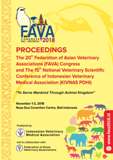PF-11 Isolation and Identification of Gram-Negative Bacterial Pathogens of Bat Guano from Liang Bukal and Liang Petang Cave on Sumbawa Island
Abstract
Bats are important reservoirs of many bacteria. The occurrence of infectious diseases that caused by Gram-negative bacteria has increased the interest in bats as potential reservoir hosts of many bacteria. Several bacteria, including Salmonella spp, Escherichia coli, and Bartonella spp were isolated from wild bats in various country [1]. Despite the fact that little is known about the bats as a reservoir of gram-negative bacterial pathogens in Sumbawa, Indonesia.
Gram-negative bacteria can cause human disease was isolated from fresh bat guano of Rousettus leschenaultii at the Robber’s Cave, Mahabaleshwar, Maharashtra, India, including Escherichia coli, Yersinia, Enterobacter and Proteus [2]. In Pakistan, Gram-negative bacteria like Salmonella and Pseudomonas, Bartonella, and Klebsiella was isolated from guano of Indian flying fox (Pteropus giganteus) [3].
Bat guano was used as fertilizer with a farmer in Sumbawa Island. So, Close contact between human and bat guano, it is possible the gram-negative bacteria from guano can infect the human. The present study reported that close contact with both domestic animals and humans, contaminating houses with guano and urine, additionally, humans occasionally encroach into bat habitats [4].
Sumbawa Island has many caves for breeding place of bats. Identification of gram-negative bacterial pathogens from bat caves which are a risk to human, animal and environment health on Sumbawa Island is needed as early detection of the presence of Gram-negative bacterial pathogens from bat guano.

